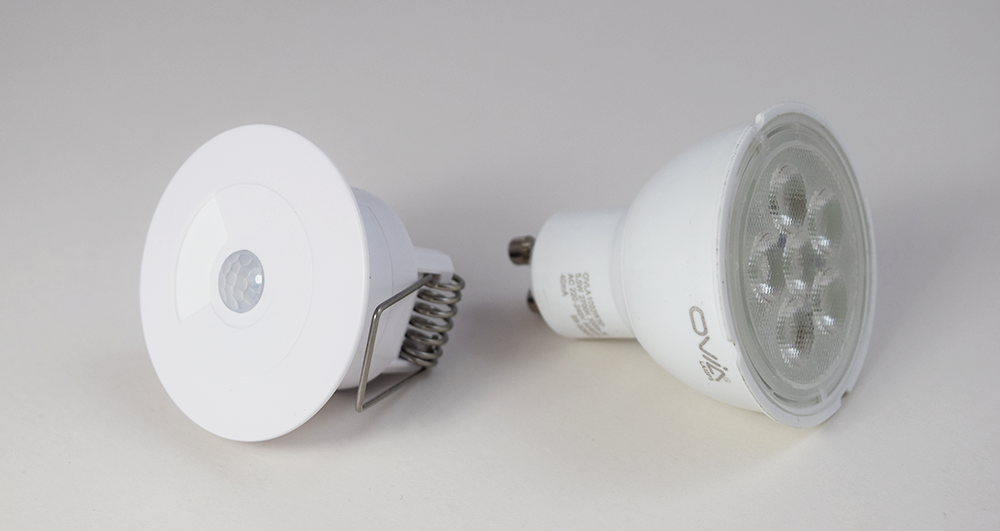
What motion sensor do I need?
Ensuring you pick the right sensor for your project is essential to ensuring your overall system functions as expected.
Faradite motion sensors are designed to connect to low voltage smart home / building automation control systems. Our sensors are not designed to turn on/off 240V AC lights directly; they are designed to be connected to a control system. Which will then in turn, turn lights on or off, boost the heating or any other function the integrator wishes to trigger from the motion detected event.
Almost all home, building and lighting controllers on the market have an input available for simple devices that simply report their status by turning on/off. This enables the integrator to integrate motion sensors, door contacts, push buttons etc into the overall smart home automation solution.
TYPES OF INPUTS
These inputs are referred to by many names, depending on the controller used (digital inputs, contact closures and contact inputs etc). For the rest of this blog, we will generically refer to these as “inputs”.
There are two types of input:
- Voltage detection – these types of input measure the voltage signal of the connected device, typically looking for a ~12-24V signal
- Dry Contact / Volt Free – these inputs detect if there is a complete circuit between two terminals
The diagram below shows how these two types of input would typically be wired.

Please note that with some controllers you will be able to specify if the input is in voltage detection or closure detection mode, when other systems are fixed to one or the other. Please refer to the manufactures' guidance about which type of input your control system expects.
ANALOG INPUTS
Some control systems have analog inputs for use with sensors that have a variable value rather than just 'on/off'. These inputs typically take a voltage between 0-10V. The Faradite Motion Sensor 360 (LUX 0-10V) sensor has a 0-10V light sensor output that can be connected to these inputs.
But be careful - don’t confuse these 0-10V inputs with 0-10V outputs which are typically used in some older systems to dim lighting ballasts.
The Faradite Motion Sensor 360 (LUX 0-10V) has a 0-10V output and can be mapped as follows: 0V = 0 LUX and 10V = 1000 LUX.
Typically, the controller is programmed to make use of this value i.e. only turn on the lights when the motion detected event is triggered if the LUX level is lower than 300 LUX (3V).
VOLT FREE vs DRY CONTACT
To avoid any confusion, there are two main terms used to refer to a device that has a switch or relay with both of its terminals exposed for connection; volt free or dry contact. These terms can be used interchangeably, and, for the remainder of this blog, we will refer to this type of connection exclusively as volt free.
NORMALLY OPEN VS NORMALLY CLOSED
There are two types of volt free devices, 'normally open' and 'normally closed'. Normally open devices are turned off (i.e. no connection between the terminals) when in their default state, when triggered they close and a connection is made. Normally closed devices are the opposite; they are normally closed and when triggered they open. All Faradite’s motion sensors are normally open.
If the control system being used expects a normally closed input then there is generally an option either on the controller or in the controllers' software to invert the input. Care should be taken to select the right type of input when programming the system to avoid any odd behaviour during commissioning.
TIMEOUT
Our sensors have a ~1 second timeout so that after the subject has stopped moving or moved outside the detection cone, the sensor will return to an open state after 1 second.
We therefore recommend using a timer in the control software to turn the light off after a set duration of time, depending on the controller this might require a timer to be implemented in the control logic. Some controllers have the timer functionality built into the lighting control logic and therefore one simply must adjust the software parameters to suit. Please see the manufactures' guidance on how to use volt free motion sensors for more information.
CHOICE OF SENSOR
The table below shows our two sensors and their compatibility with the various types of input that we have discussed in this blog.
So, to conclude, the choice of sensor is simply based on the type of input that the controller expects. If you are unsure which sensor is most suited to your project, please don’t hesitate to get in contact and we will be more than happy to advise.


